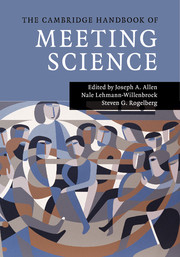Book contents
- The Cambridge Handbook of Meeting Science
- The Cambridge Handbook of Meeting Science
- Copyright page
- Dedication
- Contents
- Tables
- Figures
- Contributors
- Book part
- Part I Introduction
- Part II Premeeting Activities and Context
- Part III The Meeting Itself
- Capturing and Understanding Dynamics and Processes of the Meeting
- 12 Meetings as Interactional Achievements
- 13 Multimodal Perspectives on Meeting Interaction
- 14 Toward a Theory of Strategic Meeting Interaction
- 15 Social Dynamics at Work
- 16 Networks in Meetings
- 17 Effective Leader Behaviors in Regularly Held Staff Meetings
- 18 They Meet, They Talk…but Nothing Changes
- 19 Relative Status and Emotion Regulation in Workplace Meetings
- 20 Dynamic Affect in Team Meetings
- Tools and Models for Promoting Meeting Success
- Part IV Special Types of Meetings
- Part V Synthesis and Conclusion
- Book part
- Author Index
- Subject Index
- References
19 - Relative Status and Emotion Regulation in Workplace Meetings
A Conceptual Model
from Capturing and Understanding Dynamics and Processes of the Meeting
Published online by Cambridge University Press: 05 August 2015
- The Cambridge Handbook of Meeting Science
- The Cambridge Handbook of Meeting Science
- Copyright page
- Dedication
- Contents
- Tables
- Figures
- Contributors
- Book part
- Part I Introduction
- Part II Premeeting Activities and Context
- Part III The Meeting Itself
- Capturing and Understanding Dynamics and Processes of the Meeting
- 12 Meetings as Interactional Achievements
- 13 Multimodal Perspectives on Meeting Interaction
- 14 Toward a Theory of Strategic Meeting Interaction
- 15 Social Dynamics at Work
- 16 Networks in Meetings
- 17 Effective Leader Behaviors in Regularly Held Staff Meetings
- 18 They Meet, They Talk…but Nothing Changes
- 19 Relative Status and Emotion Regulation in Workplace Meetings
- 20 Dynamic Affect in Team Meetings
- Tools and Models for Promoting Meeting Success
- Part IV Special Types of Meetings
- Part V Synthesis and Conclusion
- Book part
- Author Index
- Subject Index
- References
Summary
Emotion regulation is the human ability to manipulate or control the experience of and the expression of emotions. Recent research demonstrates that emotion regulation occurs in workplace meetings. In this chapter, we describe workplace meetings as emotion regulation episodes and construct a multilevel conceptual model of emotion regulation in workplace meetings. Drawing on status characteristics theories, we develop a series of propositions to suggest that power and status dynamics are predictive of emotion regulation in workplace meetings. We also propose individual (e.g., personality) and group-level (e.g., psychological safety climate) differences that may affect the relationship between status and emotion regulation. Finally, we discuss the outcomes of emotion regulation in workplace meetings and provide suggestions for meeting facilitators.
- Type
- Chapter
- Information
- The Cambridge Handbook of Meeting Science , pp. 440 - 455Publisher: Cambridge University PressPrint publication year: 2015

